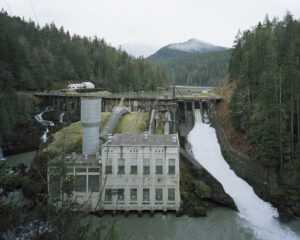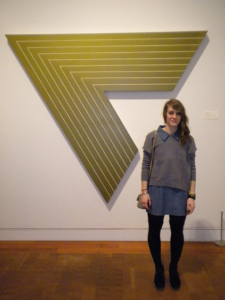Today’s blog post comes from Curtis Eckley, Class of 2019 and Art Center Student Docent.
On April 20, 2017, Late Night at the Lehman Loeb saw the surfacing of some of the Art Center’s more elusive yet fascinating works from the collection through a faculty talk given by Professor of Anthropology and Latin American & Latinx Studies David Tavárez on Mesoamerican artifacts, and an Art Majors talk given by Zoe Lemelson ’17 on contemporary photographer, Doug Rickard. In conjunction with the Anthropology class, Mesoamerican Worlds, Tavárez discussed the intersections of life, death, and memory in Ancient Mexico through a diverse group of ceramic and stone objects produced during the Formative period (2000 BCE-200 CE), Classic period (200 CE-1000 CE), and Postclassic period (1000 CE-1697 CE) of pre-Columbian history. The artifacts in the exhibition comprised a mix of works from the Loeb’s collection, as well as works on loan from private collections, and came from three cultural regions in West Central Mesoamerica, including Nayarit, Colima, and Jalisco; from ancient Zapotec sites and Teotihuacan in Central Mesoamerica; and from Mayan sites in Southeastern Mesoamerica, and Central Veracruz.

Many of the works come from the tradition of burying high-status individuals in underground chambers made accessible by a shaft with an opening, a practice found throughout Mesoamerica. Burial chambers were commonly filled with anthropomorphic and zoomorphic clay figures such as warriors, animals, ball players, musicians, and ritualists. The clay figures, often made with molds and without glazes, provide insight into how the peoples of ancient Mesoamerica lived and viewed themselves and the world around them. For instance, some figures depict the practice of head binding, while others demonstrate an excess of ornamentation for male figures, and a lack of ornamentation for female figures. One work depicts a vessel with a turkey head in place of the handle, highlighting the importance of the bird in ritualized practices. Tavárez compares the unique place turkeys had in special events to the way in which turkeys are eaten every year during Thanksgiving dinners. Over time these chambers would gradually be reopened, especially in post-Independence Mexico when farmers who had chambers on their plots of land would sell the wares to buyers looking towards ancient Mexico to provide cultural inspiration for the newly independent state. As Tavárez notes, artists like Diego Rivera and Frida Kahlo collected many such works in attempts to foster a collective memory and identity for the Mexican people.

Lemelson’s talk on Doug Rickard’s 2011 photograph, #40.805712, New York City, NY (2009), highlighted the growing presence of contemporary art in the Loeb’s collection, as well the new avenues documentary photographers are taking in the digital age. Rickard’s work is an example of the photographs he takes using a 35mm camera (the camera of choice for street photographers) that he instead points towards his computer screen at images found on Google Street View. The image discussed was taken in New York City, and depicts two men standing on an otherwise barren street among boarded up shops and windows. What Rickard reveals is the way in which marginalized neighborhoods are not just forgotten economically, but also digitally, as Lemelson points out that the images taken in such neighborhoods are not updated as frequently, and are instead much more pixelated and blurry. Ultimately, both Tavárez’s and Lemelson’s talks served to highlight neglected parts of history and society that demand attention in order to address the issues at play. While Tavárez looks to ancient Mesoamerica to find this inspiration, Lemelson relies on the work of Rickard to scan the many plights of contemporary society, and through these works discussed, memory can serve not just as way of looking at the past, but as a way of moving into the future.

Purchase, Advisory Council for Photography, 2013.12




